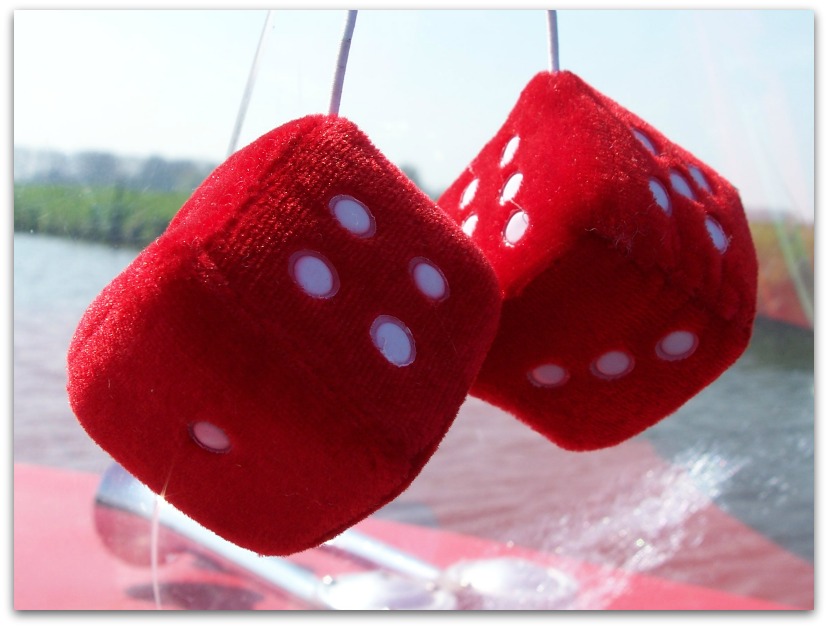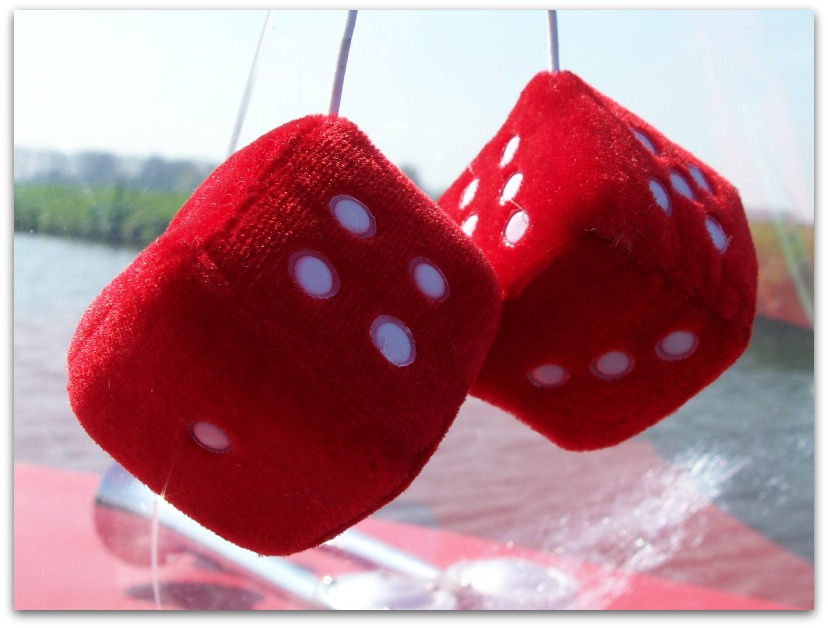Early automobiles were boring black boxes, devoid of personality…until all this stuff came along to spice things up. So honk if you like car-accessory origins! (This story was originally published in the 28th annual edition, Uncle John’s Factastic Bathroom Reader.)
Fuzzy Dice
During World War II, American fighter pilots glued ordinary game dice to their instrument panels, arranged so that seven dots, or “pips,” were visible—a lucky 7. It was a good-luck charm for the dangerous combat missions they flew. After the war, thousands of former fighter pilots and airplane mechanics got caught up in America’s burgeoning car culture—in particular, building and customizing hot rods. One small customization was a holdover from the war: hanging a pair of plastic dice over the rearview mirror. Mark Shepherd was aware of the fad— he’d been a radar and electronics technician in the navy during World War II. While working at Texas Instruments in 1952 (where he helped develop the integrated circuit and eventually became CEO), he asked a toy maker to create some dice for him, but extra-large and plush, so that they were soft like a stuffed animal instead of hard plastic. Shepherd gave them as a good-luck gift to a friend who was into hot rods and drag racing, and it caught on.
Bumper Stickers
Forest Gill ran a silk-screen printing business in Kansas City in the late 1930s, manufacturing canvas awnings for local businesses with their name printed on them. In 1946 he heard about new “DayGlo” inks developed by a printing company in Cleveland—bright colors that glowed in the daytime and also didn’t fade or run when exposed to rain. Gill started offering them on his awnings, but around the same time, he became aware of another new technology—thin cardboard with a paper backing that, when peeled off, exposed pressure-sensitive adhesive tape. That gave him an idea. He combined the DayGlo inks with the sticker board to create a brightly colored card with a message on it that people could stick to their cars. He got the idea from a Tennessee tourist attraction called Rock City. Cars would get a free piece of cardboard that read “See Rock City,” which an employee would tie to the bumper with wire. The signs could be seen on cars all over the South and Midwest. Gill presented his idea to the Nationwide Advertising Specialty Company, which in turn sold his “bumper stickers”—the perfect inexpensive souvenir for car owners in the 1950s—to tourist destinations nationwide (including Rock City).
Sexy Lady Mudflaps
California-based long-haul trucker Stewart Allen liked to decorate the inside of his rig with pictures of his wife, Rachel Ann Allen. His favorite: a photo of her sitting on the beach, wearing a swimsuit, hair flapping in the wind. But when a new boss at his trucking company told him to stop decorating his truck with personal items, inspiration struck. He turned the photo into a silhouette and had a metal fabricator create a chrome version, which he had the fabricator affix to a sheet of rubber. Result: his wife’s figure on mudflaps, which were far less likely to be noticed by his boss. In 1967 Allen’s friend Bill Zinda asked if he could reproduce and sell the mudflaps as part of a line of truck accessories. Allen agreed, and those mudflaps depicting Rachel Ann became very popular as trucking culture captivated America in the 1970s. Neither man had bothered to trademark the image, though, so Zinda’s sexy lady mudflaps were widely copied. The trademark for the original image is now owned by fashion designer Ed Allen—Stewart and Rachel Ann’s son. In 2009 he released a line of T-shirts showing off his mother’s figure.
The “Front-End Bra”
Bill Colgan ran Colgan Custom Manufacturing in Burbank, California, in the 1950s, designing custom upholstery for boats and cars. In 1960 three German engineers who worked at a nearby Lockheed plant asked Colgan to make a custom cover for the front end of each of their Porsches. For reference, they gave Colgan what they’d been using to protect their cars: Porsche road-test covers made of canvas, with wooden slats, hooks, and rubber bands sewn in. Six weeks later, Colgan had crafted 12 covers out of vinyl and leather, and lined with felt. Colgan called it a “bra” because it fit tightly around the front of a car, and to him it looked like a brassiere. The engineers referred Colgan to Porsche, which contracted him to make 150 more, and then hundreds more. By 1975 Colgan was manufacturing thousands of bras a year for various makes and models. As Porsche had used the cover to road-test new cars without damaging the front end, Colgan’s bra promised to protect the bumper and hood from scratches and paint wear. (It’s also a way to conceal front-end damage.) Only thing: according to some auto experts, bras have big downsides—they catch air (which slows down the car) and retain moisture (which actually accelerates the paint’s decay).










